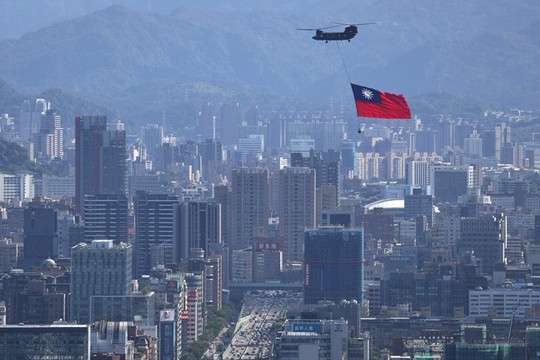Taiwan is unlikely to thwart Chinese military air superiority in a cross-strait conflict, while tactics such as China’s use of civilian ships for military purposes have eroded U.S. spy agencies’ ability to detect a pending invasion, according to leaked Pentagon assessments that contain troubling details about the self-governed island’s ability to fend off war, ‘The Washington Post’ writes in its inquiry.
The assessments state that Taiwan officials doubt their air defenses can “accurately detect missile launches,” that barely more than half of Taiwan’s aircraft are fully mission capable and that moving the jets to shelters would take at least a week — a huge problem if China launched missiles before Taiwan had a chance to disperse those planes.
The classified documents addressing a potential conflict suggest China’s air force would have a much better shot at establishing early control of the skies — a strategy that Taipei itself believes will underpin an attack. Dozens of highly classified documents have been leaked online, revealing sensitive information intended for senior military and intelligence leaders.
In an exclusive investigation, ‘The Post’ reviewed scores of additional secret documents, most of which have not been made public.
The revelations about Taiwan’s readiness come as U.S.-China relations are at their lowest point in decades and concerns continue to grow about a potential conflict between Taipei and the People’s Liberation Army (PLA), China’s fast-modernizing military that is roughly 14 times the size of its neighbor’s force.
One assessment notes that the PLA’s modernization, its heightened operations tempo and the use of civilian ferries in exercises in the Eastern Theater Command near Taiwan are “eroding” the U.S. intelligence community’s ability to detect abnormal activity and preparations for “an attack on Taiwan.”
Another assessment takes aim at Taiwan’s military and civilian preparedness. It says the island’s current doctrine of firing two air defense missiles per target “would be strained under high-volume PLA fires” from China’s short-range ballistic missile system, dispersed across multiple moving launch platforms. Taiwanese airmen train for shooting at single unmoving targets.
Moreover, Pentagon analysts note, Taiwan’s missile warning drills are highly scripted and inadequate for steeling civil authorities and the public for “a real-world event.”
Though far from a comprehensive analysis of China’s capabilities and Taiwan’s vulnerabilities, the documents collectively paint a grimmer picture of Taiwan’s overall readiness. They also serve as a warning to policymakers that China’s aggression is becoming more intense even as its intentions become less predictable.
CIA Director William J. Burns has said Chinese President Xi Jinping has directed that his military be capable of seizing Taiwan by the PLA’s centennial in 2027. But that doesn’t necessarily mean he will deploy troops then or at any other time, Burns hastened to add, saying he believes Xi and his military leadership have doubts about whether an invasion would be successful. The Russians’ experience in Ukraine has “probably reinforced some of those doubts as well,” Burns told CBS’ “Face the Nation” in February.
Gen. Mark A. Milley, chairman of the Joint Chiefs of Staff, said in November that the Pentagon is working to make sure that Taipei can defend itself and that the U.S. military is prepared should the island be invaded…
China’s intensifying military activity around Taiwan is undermining the intelligence community’s ability to accurately track what is normal and what is escalatory, raising the risk of accidents and miscalculation, the assessments warn. Beijing has carried out “large-scale military exercises simulating amphibious assaults, blockades, air raids and joint fire power strikes” twice within the last eight months, most notably after the visit of then-House Speaker Nancy Pelosi (D-Calif.) to Taiwan in August, when it launched ballistic missiles over the island and sent dozens of jets across the unofficial sea border between the two jurisdictions.
The most recent activity — following this month’s meeting between Taiwan President Tsai Ing-wen and House Speaker Kevin McCarthy (R-Calif.) in California — wasn’t as bellicose. Should future exercises get significantly larger, that would make judgments about China’s intentions more difficult, said Joel Wuthnow, a senior research fellow at National Defense University.
Distance is a significant complicating factor in a defense-of-Taiwan scenario, experts agree. “We cannot get there quickly,” said Oriana Skylar Mastro, a fellow at Stanford University’s Freeman Spogli Institute for International Studies and at the American Enterprise Institute. “It’s basically submarines and U.S. aircraft that are going to be operating from the southwest islands of Japan and eventually from bases in the northern Philippines. If China takes out those bases, the United States doesn’t have a lot of options.”
In the event of a conflict, however, one assessment expects that China will “very likely” seek to use its space capabilities to disable U.S. satellites in an effort to deprive the United States of useful intelligence. It also may rely on satellites for long-range strikes on U.S. ships, subs and jets spread across the vast Pacific, the document states, ‘The WP’ concludes.
read more in our Telegram-channel https://t.me/The_International_Affairs

 11:37 18.04.2023 •
11:37 18.04.2023 •























